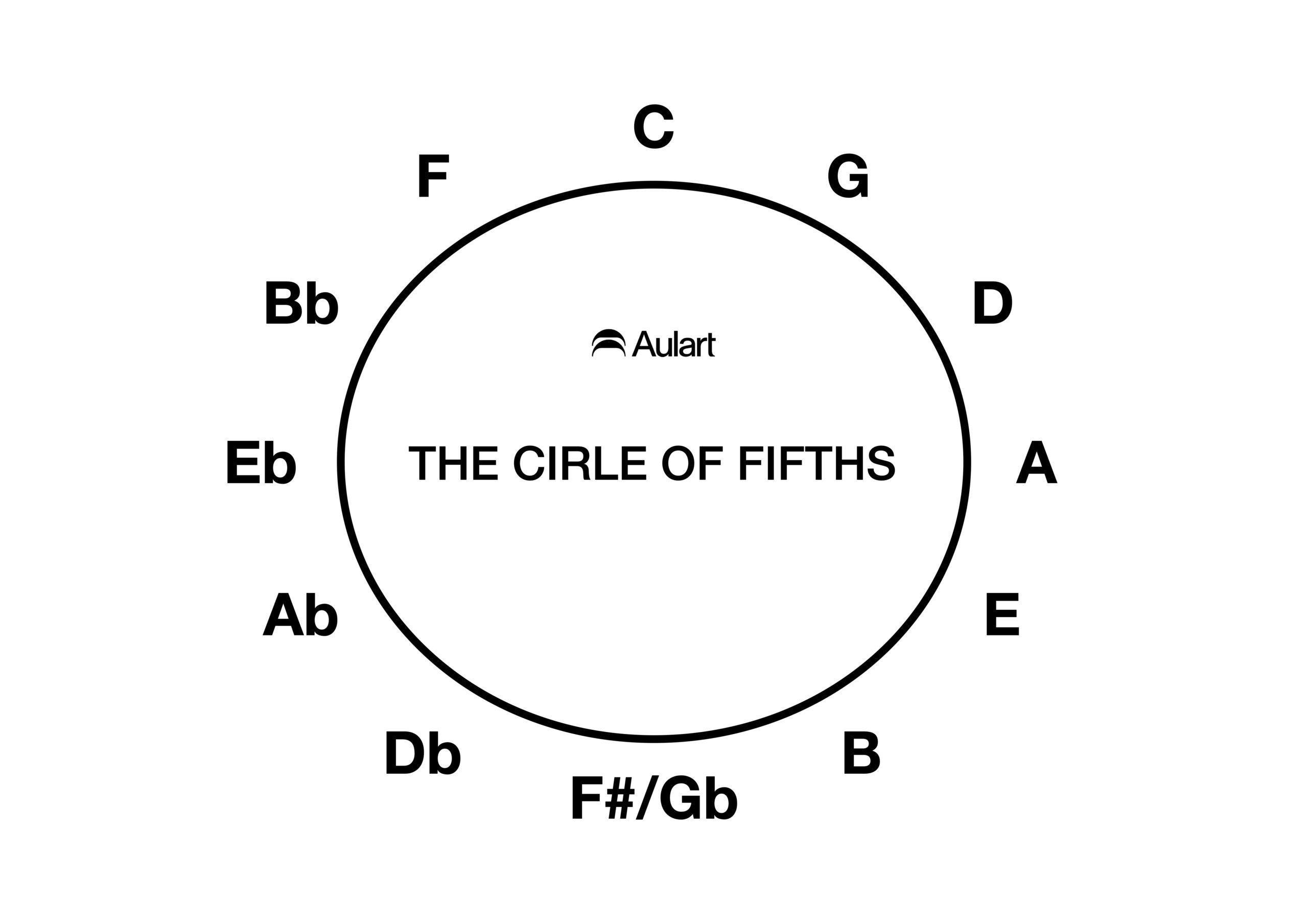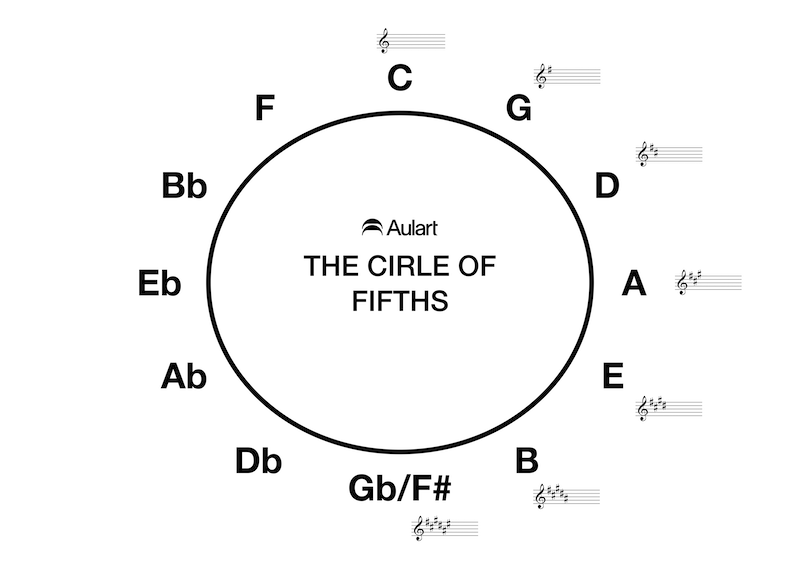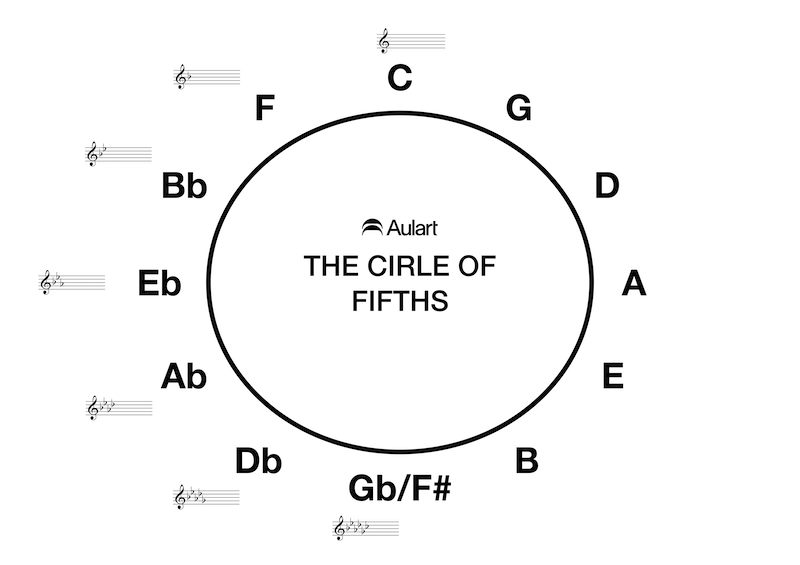What is The Circle Of Fifths?
The Circle Of Fifths is a musical tool that sums up scales, notes, chords and modes in a unique simple diagram. It is one of the most used tools to learn music theory and to predict chords in a progression, understand relationships between major and minor keys and even help you write music.
The Circle Of Fifths was created by a Russian composer and music theorist named Nikolay Diletsky who invented this wheel in the late 1670’s. It was part of his book Grammatika, a guide to composition with the rules of music in mind. Since then, it has been improved to fit all musical concepts in one wheel.
Let’s start with some theory
Before we dive into how the Circle of Fifths functions and the mechanics of the circle, it is very important to understand some key concepts and definitions that we are going to refer to during this blog.
Every step or station of the circle represents a note, a chord or a key. But let’s get deeper in the definition of this concepts:
- Note: in music, a note is a symbol that represents a specific pitch and duration. The pitch of the note is indicated in a five-line staff with four spaces called pentagram and the duration is indicated with its shape. Notes can be altered in pitch by accidentals: sharps and flats, which raise or lower the pitch of the note.
- Chord: in music, a chord is a stack of 3 or more notes played together that creates harmony. They are used to create tonal structure and convey emotion through harmony.
- Key: in music, when we use the term key we refer to the tonal center of a song. The tonal center is the pillar where the harmony and the melody of the song revolves around. This tonal center is a unique note that we define as the root and it receives the scale degree designation “I”. Starting from this note, a succession of notes will be created, originating a scale.
- Intervals: in music, an interval is the distance between two pitches or musical notes. The distance is measured in steps (whole step and half step) and every interval has a fixed specific number of steps. The most common intervals are unison, second, third, fourth, fifth, sixth, seventh and octave.
- Fifth: a fifth is an interval created by a distance of four steps (either four whole steps or three whole steps and a half step). The most common type are the perfect fifth and they receive this name for the perfect harmony and sound they produce. There is a mathematical algorithm that can scientifically demonstrate the resonance of the interval and why it produces this “perfect” sound, but we are not going to get into details in this blog.
Introducing The Circle Of Fifths
By definition, the Circle of Fifths is a visual tool designed to illustrate the relationships between the 12 tones of the chromatic scale – the foundation on which Western music is built. The name comes from the fact that going on a clockwise movement around the circle, each note is an interval of a fifth above the previous one. Because of that, this wheel shows how all the musical notes, keys and chords relate to each other.

How to build a basic Circle Of Fifths
In order to be able to better understand the Circle of Fifths, let’s start by building a basic one that will connect every note that exists in the distance of a fifth. Let’s start by positioning the note of C at 12 o’clock. Now, let’s move clockwise by an interval of a perfect fifth (four whole steps). This will create the following sequence: C-G-D-A-E-B-F#-C#/Db-G#/Ab-D#/Eb-A#/Bb-F-C.
If you pay close attention, you will see that after C#, we start calling it by two different names. This effect is called an enharmonic. A C# and Db, for instance, are the exact same note. To make it simple and not have a huge amount of sharps and flats in the key signature (will explain later), we change the name so it’s easier to write and also play in many instruments.
Another interesting thing is that the notes that we have written aren’t just plain notes, they are also keys or tonal centers. So, in the future when we analyze how we can use the Circle of Fifths to find chords, scales, modes or relative minors, just spin the wheel until you have your desired note at 12 o’clock and copy the procedure.
Figuring Out Key Signatures
The Circle of Fifths is one of the most useful tools to determine a key signature. In the next section, we are going to show you how simple it is to find a key signature from any key that you want.
In order to find easily any key signature that exists, let’s start by looking at the Circle of Fifths with the C at the position of 12 o’clock. C major and its relative minor, A minor, are the only keys that have no sharps and no flats. This is why we called it a neutral key. Because of its neutrality, we are placing it at 12 o’clock so the following technique applies:
- Key signatures with sharps (#): to know how many sharps a desired key signature has, we are going to move clockwise through the Circle of Fifths. Every step we move, it will add one SHARP until the whole circle is complete.

- Key signatures with flats (♭): to know how many flats a desired key signature has, we are going to do the opposite than before: move counterclockwise through the Circle of Fifths. Every step we move, we will add one FLAT until the whole circle is complete.

As we mentioned before, due to enharmonics and simplicity, after Gb or F#, we are switching names so we never have more than 6 flats or 6 sharps. Playing with a key signature of more than 6 accidentals is very complicated and not often seen in any genre of music.
TIP: to know the notes of the accidentals and the order that are used, for SHARPS, start on F and move clockwise, and for FLATS, start on B and move counterclockwise.
What About Minor Keys?
So far, the Circle of Fifths we’ve presented you only had major keys and key signatures. In order to find minor keys and their key signatures, we can use the same Circle of Fifths in the following way.
Every major key has a relative minor key. We call it relative because they share the key signature. A major key and its relative minor use the exact same notes and scale but starting from a different note acting as a root. Here are two ways to find a relative minor key:
- Write every note of the major scale of the key you choose on a piece of paper or play it on an instrument. The relative minor tonic will be on the sixth degree of the scale (the sixth note). In terms of intervals, that’s a major sixth going up the scale or a minor third down going down the scale.
- Using the Circle of Fifths, move three positions clockwise around the circle to find the relative minor. So, if we start on C, count 1 (G), 2 (D) and then 3: A. The relative minor key of C major is A minor.
If you pay attention, you will see that once we have found the first relative minor key (A minor), you can find the rest of them by going an interval of a fifth up, as we did before with the major keys.
The reason why it’s called the Circle of Fifths is pretty obvious at this point: adjacent keys of both major and minor keys are separated by an interval of a perfect fifth when moving clockwise. Nonetheless, you might have heard about the Circle of Fourths. Don’t worry, it’s the exact same thing. If you move counterclockwise through the wheel, you will find that the distance that appears is a perfect fourth (two whole steps and one half step). The Circle of Fourths is just another way of calling The Circle of Fifths.
Modes and the Circle of Fifths
Before we go deep into how the Circle of Fifths can be used in your everyday practice, let’s get a little more technical on scales. This wheel is also very useful to find out the notes that correspond to every mode scale, not just simply major and minor.
A mode in music is a scale with the tonal center pivoted to another note of the major scale. For example, if we pick C as a key, the tonal center will be C and it will be the root. This mode is called major mode (major scale). If we now pivot the tonal center to the 6th degree or note (A), with the same scale, now we have the minor mode (minor scale). But, this doesn’t end here. You can move your tonal center to every note of the scale creating a new mode for every note. Let’s do an example in C:
- C as tonal center – it is called Major Mode or Ionian Mode
- D as tonal center – it is called Dorian Mode
- E as tonal center – it is called Phrygian Mode
- F as tonal center – it is called Lydian Mode
- G as tonal center – it is called Mixolydian Mode
- A as tonal center – it is called Minor Mode or Aeolian Mode
- B as tonal center – it is called Locrian Mode
All these modes can be found in the Circle of Fifths. To find them, you should follow this rules:
- Major Mode: start from 1 position to the left of 12 o’clock. That note and the following 6 moving clockwise will make a major or ionian scale.
- Dorian Mode: start from 3 positions to the left of 12 o’clock. That note and the following 6 moving clockwise will make a dorian scale.
- Phrygian Mode: start from 5 positions to the left of 12 o’clock. That note and the following 6 moving clockwise will make a phrygian scale.
- Lydian Mode: start from 12 o’clock position. That note and the following 6 moving clockwise will make a lydian scale.
- Mixolydian Mode: start from 2 positions to the left of 12 o’clock. That note and the following 6 moving clockwise will make a mixolydian scale.
- Minor Mode: start from 4 positions to the left of 12 o’clock. That note and the following 6 moving clockwise will make a minor or aeolian scale.
- Locrian Mode: start from 6 positions to the left of 12 o’clock. That note and the following 6 moving clockwise will make a phrygian scale.
- Chromatic scale: start from 12 o’clock position. Move around the whole wheel and every note will create a chromatic scale.
Every mode and scale has a different sonority. Some of them convey tension and agony while some convey happiness and joy. Feel free to play them on an instrument and discover for yourself how they sound.
Using the Circle of Fifths to find Key Signatures
Let’s try to put the Circle of Fifths in use. Let’s find the key signature of D, for instance. Remember, we will move around the wheel until we find our desired chord.
In order to find the key signature of D, first we need to find the note in the Circle of Fifths – remember, we always start from the C. If we move clockwise, we will find G. That is not the desired note. Let’s move one more step. Now we are in D, our goal. In order to get from C to D we have moved two steps clockwise. This means that the key signature for D major will be two sharps.
Let’s do one more example, let’s find the key signature for Bb major. If we have a quick look at the Circle of Fifths, we will realize that Bb is on the left side of C and it would be much faster to get there by moving counterclockwise. So again, let’s start at C. If we move one step counterclockwise we will find F. If we move once again counterclockwise, we will find Bb – our desired note. In order to get here, we have moved two steps counterclockwise, so this means that the key signature of Bb is two flats.
Remember, if we move clockwise from C we will be adding sharps in the key signature. If we move counterclockwise from C (because it’s faster to get to the desired note), flats will be added to the key signature.
If you want to memorize which note represent each sharp or flat of the key signature, just remember these rules:
- Sharps: start from F and move clockwise. The order of sharps in a key signature will be F-C-G-D-A-E-B.
- Flats: start from B and move counterclockwise. The order of flats in a key signature will be B-E-A-D-G-C-F. This is the exact reverse of the order of the sharps.
This gives you the order in which flats and sharps are added to each successive key when going around the circle clockwise or counterclockwise.
All in all, the Circle of Fifths is a very basic tool to help you learn music theory, scales, and key signatures. Knowing your way around it will help improve your musical knowledge and skills, letting you increase your writing and performing skills.






 50 Industry Music Production Tips You Must Know
50 Industry Music Production Tips You Must Know




